Christman, Kate  ORCID: https://orcid.org/0000-0003-3960-9908 and Christman, Gavin
(2014)
Bee Brick.
[Device or Product]
ORCID: https://orcid.org/0000-0003-3960-9908 and Christman, Gavin
(2014)
Bee Brick.
[Device or Product]
|
Slideshow (REF Portfolio)
Kate Christman Falmouth University REF Portfolio .pdf - Supplemental Material Restricted to Falmouth staff and students only Download (3MB) | Request a copy |
|
Preview |
Other (Soil association conference - innovation awards)
G_B_Soilassociation_conference.pdf - Supplemental Material Available under License Creative Commons Attribution Non-commercial No Derivatives. Download (13MB) | Preview |
![[thumbnail of Group of bee bricks]](https://repository.falmouth.ac.uk/2078/11.hassmallThumbnailVersion/Bee_brick_group.jpg) 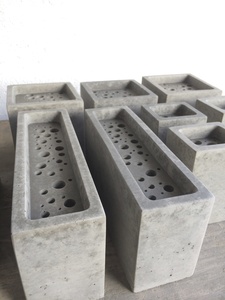 Preview |
Image (Group of bee bricks)
Bee_brick_group.jpg - Other Available under License Creative Commons Attribution Non-commercial No Derivatives. Download (1MB) | Preview |
|
Image (Bee brick design)
Bee_brick_design.JPG - Other Restricted to Repository staff only Available under License Creative Commons Attribution Non-commercial No Derivatives. Download (1MB) | Request a copy |
|
![[thumbnail of Bee brick site]](https://repository.falmouth.ac.uk/2078/13.hassmallThumbnailVersion/Bee_brick_site.jpg) 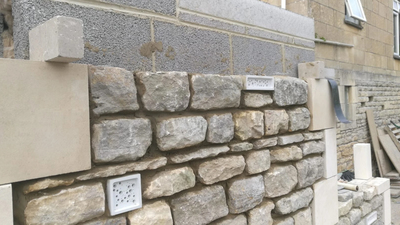 Preview |
Image (Bee brick site)
Bee_brick_site.jpg - Other Available under License Creative Commons Attribution Non-commercial No Derivatives. Download (930kB) | Preview |
![[thumbnail of Yellow Bee Brick]](https://repository.falmouth.ac.uk/2078/14.hassmallThumbnailVersion/Yellow_BB.jpg) 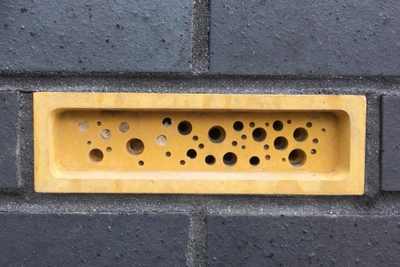 Preview |
Image (Yellow Bee Brick)
Yellow_BB.jpg - Other Available under License Creative Commons Attribution Non-commercial No Derivatives. Download (876kB) | Preview |
|
Text (Registered design, bee brick)
Reg_Design_Bee_brick.pdf - Published Version Restricted to Repository staff only Available under License Creative Commons Attribution Non-commercial No Derivatives. Download (1MB) | Request a copy |
|
Preview |
Text (Extract from Planning for Biodiversity Guide)
Planning for Biodiversity Guide p. 61.pdf - Supplemental Material Available under License Creative Commons Attribution Non-commercial No Derivatives. Download (270kB) | Preview |
![[thumbnail of Coloured bee bricks]](https://repository.falmouth.ac.uk/2078/43.hassmallThumbnailVersion/Bee_brick_colourways.jpg) 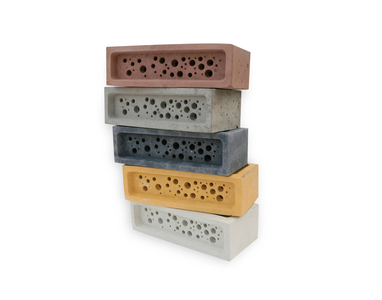 Preview |
Image (Coloured bee bricks)
Bee_brick_colourways.jpg - Other Available under License Creative Commons Attribution Non-commercial No Derivatives. Download (336kB) | Preview |
![[thumbnail of Bee using brick]](https://repository.falmouth.ac.uk/2078/44.hassmallThumbnailVersion/Bee_brick_05.png) 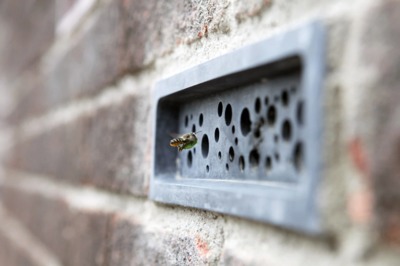 Preview |
Image (Bee using brick)
Bee_brick_05.png - Other Available under License Creative Commons Attribution Non-commercial No Derivatives. Download (2MB) | Preview |
Abstract / Summary
DESCRIBE THE IDEA
We have designed the ‘Bee Brick’ to provide a nesting site to support the declining solitary bee population. ‘Britain has more than 250 bee species, but numbers have fallen dramatically due to disease, an increase in chemical use and habitat loss (Friends of the Earth 2013). The bee brick is specifically designed to be an integral part of the build and offers the dual function of being a construction material that also promotes biodiversity. It has been designed to be included in new build projects as a ‘fit and forget’ component, and to sit alongside current green systems such as Solar panels, rainwater harvesting, ground source heat pump systems and Sedan roofs.
WHAT IS NEW ABOUT IT (100)
Main stream construction materials primary function is to perform as structural components within the fabric of new buildings. We have taken these materials as starting points, and created habitats for bee’s displaced by the construction process to become hubs for greater biodiversity within new community’s.
HOW FAR HAVE YOU PUT IT INTO PRACTICE AND WHAT ARE YOUR PLANS FOR THE FUTURE (100)
To date we have produced a working method in-house for batch production of the ‘bee brick’ along with its stand alone partner the ‘bee block’. The bee block’s can be used on their own or stacked. We are working with the structural engineering team at Plymouth university to establish its suitability as a building material and provide relevant performance tests to prove this. We are also drawing on the expertise of Bio scientist’s from Exeter university to test prototypes and working models in controlled environments and measure and record the results.
HOW DOES IT BENEFIT PEOPLE, THE ENVIRONMENT OR ANIMAL WELFARE? (UP TO 300 WORDS –
INCLUDE EVIDENCE WHERE AVAILABLE)*?
Biodiversity loss has been highlighted as a key worldwide issue. In October 2010 in Japan, over 190 countries around the world reached a historic global agreement to take urgent action to halt the loss of biodiversity. In response to this Defra’s Biodiversity 2020 strategy was created to ‘halt overall biodiversity loss, support healthy ecosystems and establish coherent ecological networks’.
This is particularly important in light of the Governments plans for additional housing. In 2007 the Government set a target of increasing the supply of housing to 240,000 additional homes per year by 2016 (Wilson, 2007).
According to English Nature not all development is harmful and, ‘given careful location and design, can even be carried out to enhance wildlife’. However, without careful attention to location, layout and design, habitats can be partially or totally destroyed. (English Nature, 2006).
The design of the bee brick is in direct response to these issues. Providing habitats for the next generation of pollinating bee species is vitally important. Adapting and rethinking how we use existing building components makes implementing these goals viable at a scale necessary to see real change and promote biodiversity.
| Item Type: | Device or Product |
|---|---|
| Subjects: | Creative Art & Design |
| Depositing User: | Kate Christman |
| Date Deposited: | 06 Mar 2017 13:39 |
| Last Modified: | 15 Nov 2024 11:29 |
| URI: | https://repository.falmouth.ac.uk/id/eprint/2078 |
 |
View Record (staff only) |

 Advanced Search
Advanced Search Tools
Tools Tools
Tools